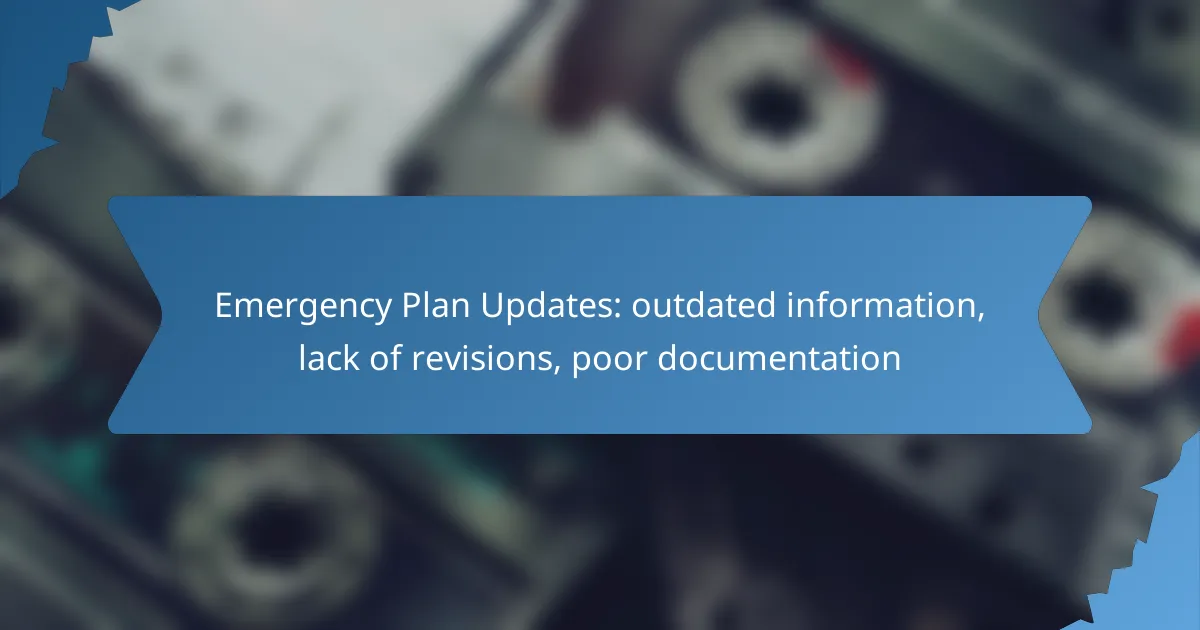Maintaining up-to-date emergency plans is crucial for effective crisis management, as outdated information can lead to delayed responses and increased confusion. Organizations must adopt a systematic approach that includes regular reviews and collaboration with local authorities to ensure their plans reflect current risks and resources. Implementing standardized documentation processes and version control systems further enhances the reliability and accessibility of emergency plans.
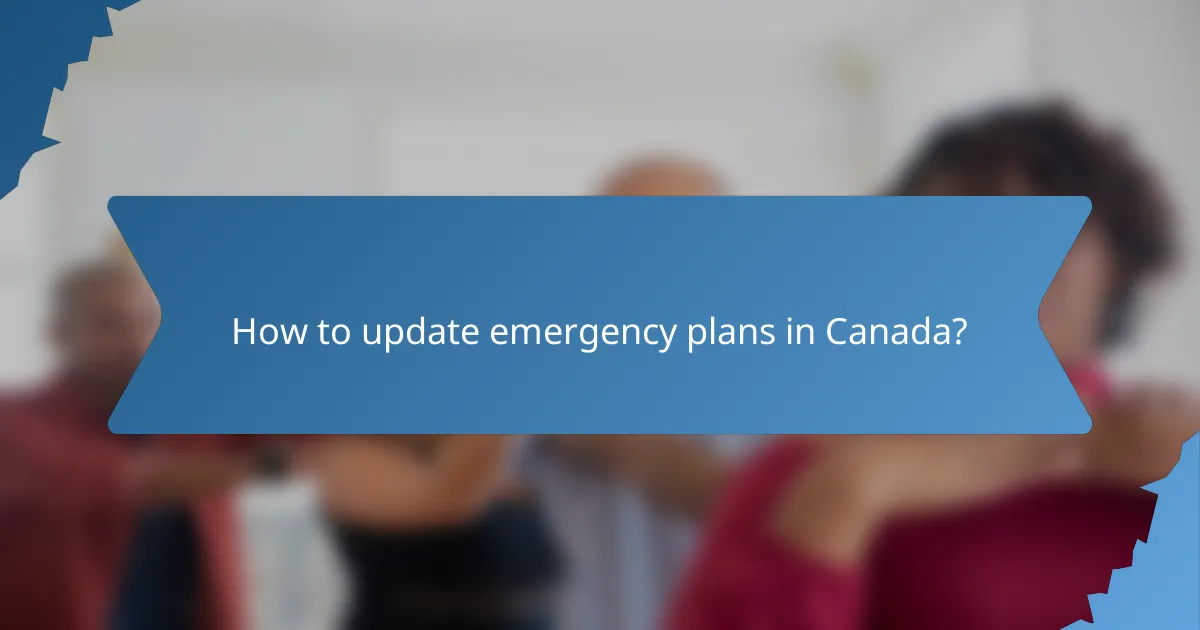
How to update emergency plans in Canada?
To update emergency plans in Canada, organizations should establish a systematic approach that includes regular reviews, collaboration with local authorities, and integration of community input. This ensures that the plans remain relevant and effective in addressing current risks and resources.
Regular review schedule
Establishing a regular review schedule is crucial for keeping emergency plans current. Aim to review and update your plans at least annually, or more frequently if significant changes occur in your organization or community. This can include changes in personnel, resources, or local hazards.
During each review, assess the effectiveness of existing procedures and identify any outdated information. Document any changes made to ensure clarity and accountability in the planning process.
Engage local authorities
Engaging local authorities is essential for creating a comprehensive emergency plan. Collaborate with municipal emergency management offices, fire departments, and police to align your plan with local protocols and resources. This partnership can enhance the plan’s effectiveness during actual emergencies.
Regular meetings with local authorities can provide insights into new regulations, available resources, and community-specific risks. This collaboration ensures that your emergency plan is not only compliant but also practical and actionable.
Incorporate community feedback
Incorporating community feedback is vital for developing an emergency plan that meets the needs of all stakeholders. Conduct surveys or hold community meetings to gather input on potential risks and preferred response strategies. This engagement fosters a sense of ownership and responsibility among community members.
Consider forming a community advisory group that can provide ongoing feedback and suggestions. This group can help identify gaps in the plan and suggest improvements based on local knowledge and experiences.
Utilize technology for updates
Utilizing technology can streamline the process of updating emergency plans. Consider using software tools that allow for easy document sharing and version control, ensuring that all stakeholders have access to the most current information. Online platforms can facilitate collaboration and feedback collection.
Additionally, leveraging data analytics can help identify trends and risks in your area, guiding necessary updates to your emergency plan. Regularly review these technological tools to ensure they meet your organization’s evolving needs.
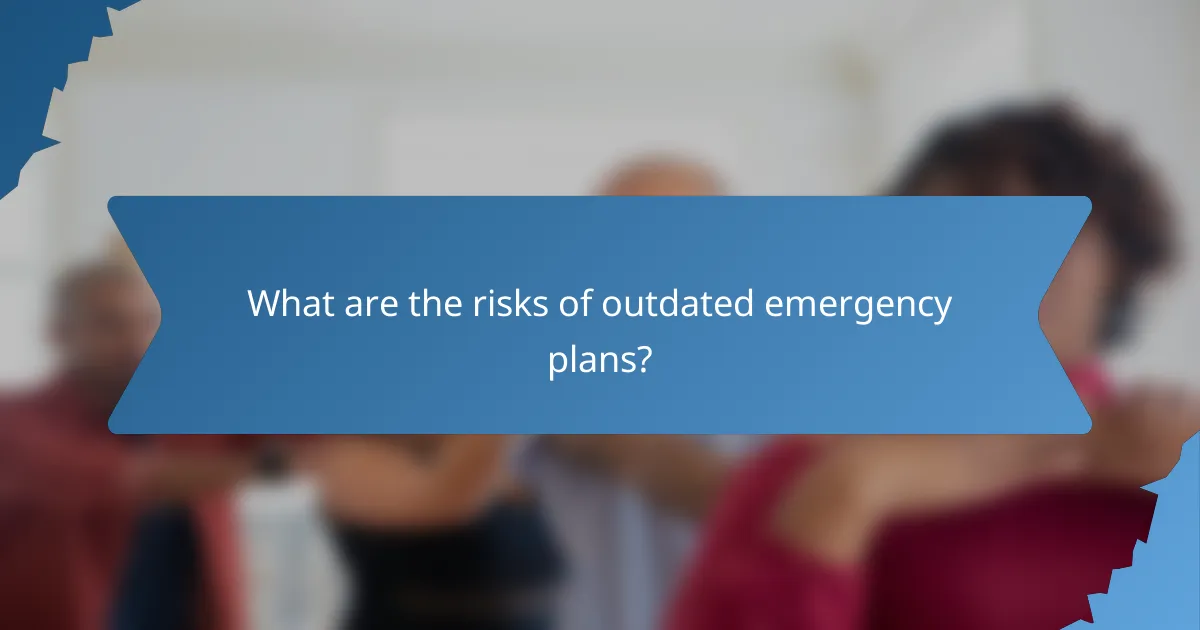
What are the risks of outdated emergency plans?
Outdated emergency plans pose significant risks, including delayed responses and increased confusion during crises. Regular updates are essential to ensure that plans reflect current conditions, resources, and best practices.
Increased response time
When emergency plans are outdated, response times can increase significantly. This delay can occur due to reliance on old protocols that may no longer be effective or relevant, leading to confusion among responders.
For instance, if an organization has not updated its evacuation routes or contact lists, personnel may waste valuable time trying to locate the correct information. Regular drills and reviews can help mitigate these delays by ensuring everyone is familiar with the most current procedures.
Miscommunication during crises
Outdated emergency plans often lead to miscommunication among team members and external agencies. If the information in the plan is incorrect or not widely disseminated, responders may not coordinate effectively, resulting in chaos during critical moments.
For example, if contact numbers for local emergency services are outdated, responders may struggle to reach necessary support. Establishing a clear communication protocol and regularly updating contact information can enhance clarity and effectiveness during emergencies.
Legal liabilities for organizations
Organizations may face legal liabilities if they fail to maintain updated emergency plans. If an incident occurs and it is determined that the organization did not follow current regulations or best practices, it could lead to lawsuits or fines.
To minimize legal risks, organizations should regularly review their emergency plans to ensure compliance with local regulations and industry standards. Documenting all updates and revisions can provide evidence of due diligence in case of an incident.
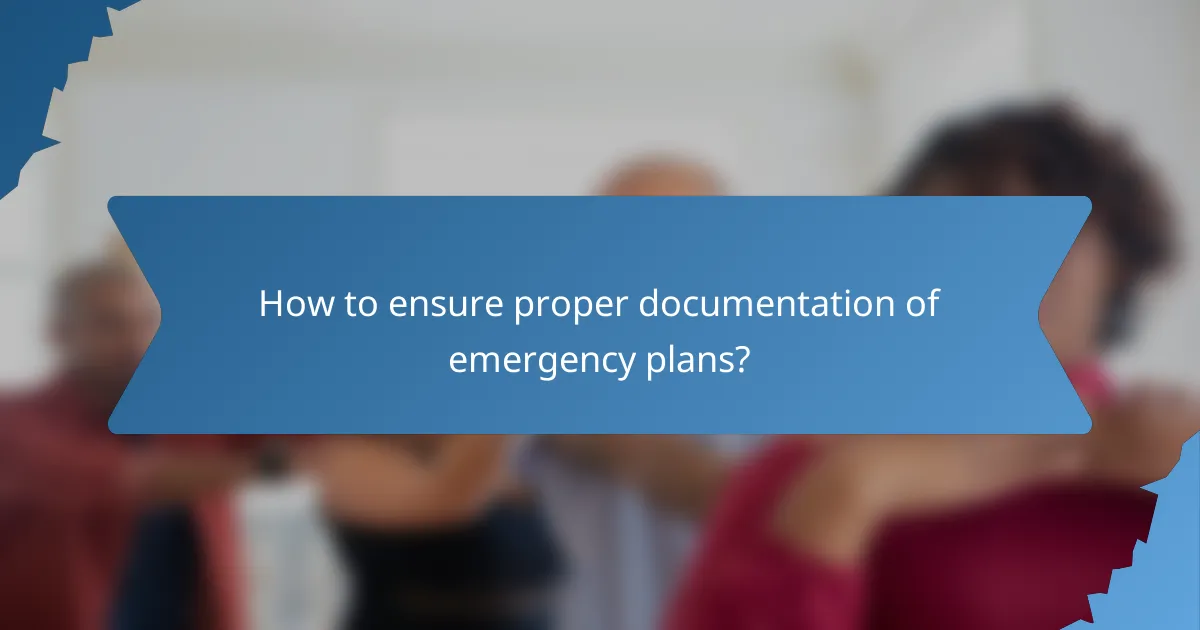
How to ensure proper documentation of emergency plans?
To ensure proper documentation of emergency plans, organizations should implement standardized processes, conduct regular training, and utilize version control systems. These strategies help maintain up-to-date and accessible emergency documentation, reducing the risk of outdated information and poor revisions.
Standardized documentation templates
Using standardized documentation templates is essential for consistency and clarity in emergency plans. Templates should include key sections such as roles and responsibilities, emergency procedures, and contact information. This uniformity allows for easier updates and ensures that all necessary information is captured.
Consider creating templates that are adaptable for different types of emergencies, such as natural disasters or workplace incidents. This flexibility helps staff quickly locate relevant information during a crisis.
Regular training for staff
Regular training for staff is crucial to ensure that everyone understands the emergency plans and their roles within them. Training sessions should be held at least annually, with additional refreshers or drills as needed. This practice keeps the information fresh and helps identify any gaps in understanding.
Incorporate scenario-based training to simulate real-life situations, allowing staff to practice their responses. This hands-on approach reinforces learning and builds confidence in executing emergency procedures.
Version control systems
Implementing version control systems helps track changes to emergency plans and ensures that all staff have access to the most current documents. This system can include a simple file naming convention that indicates the version number and date of the last update.
Regularly review and update emergency plans, ideally every six months or after any significant incident. This practice not only keeps the documentation relevant but also ensures compliance with any applicable regulations or standards.
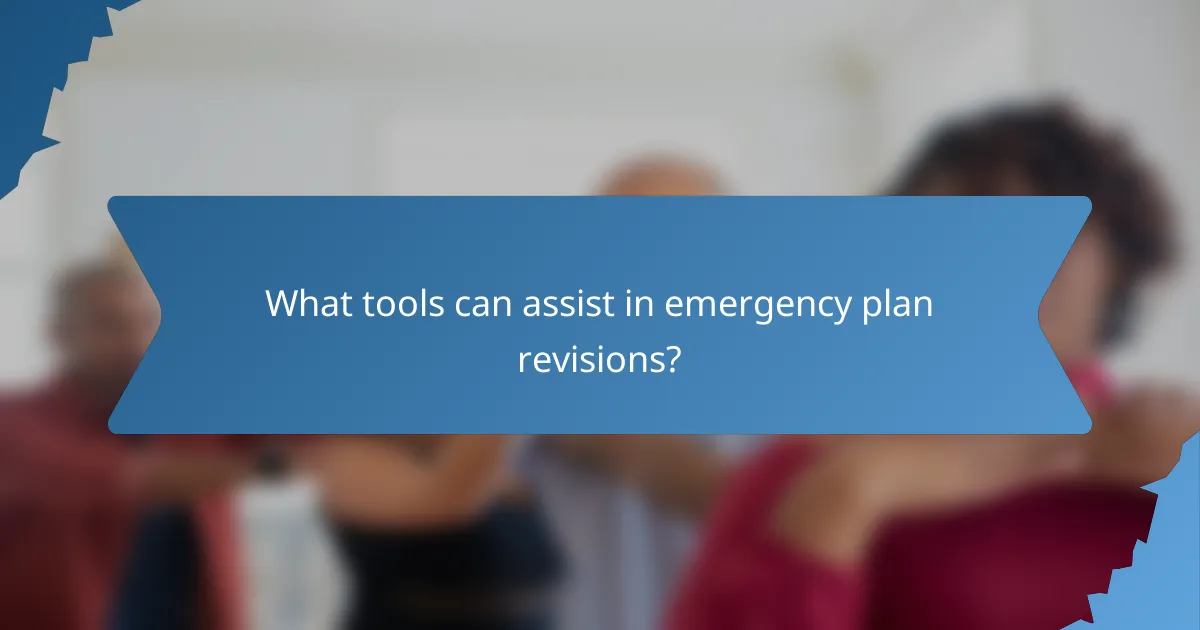
What tools can assist in emergency plan revisions?
Several tools can effectively assist in revising emergency plans, ensuring that they remain current and actionable. Utilizing emergency management software, collaboration platforms, and document management systems can streamline the revision process and enhance communication among stakeholders.
Emergency management software
Emergency management software provides a centralized platform for developing, updating, and managing emergency plans. These tools often include features for risk assessment, incident reporting, and real-time communication, which are essential for keeping plans relevant.
When selecting software, consider options that allow for easy integration with existing systems and offer customizable templates to fit specific organizational needs. Popular choices may include tools like Everbridge or WebEOC, which cater to various emergency management scenarios.
Collaboration platforms
Collaboration platforms facilitate communication and coordination among team members involved in emergency planning. Tools such as Microsoft Teams or Slack enable real-time discussions, file sharing, and project tracking, making it easier to gather input and make revisions collaboratively.
When using these platforms, establish clear guidelines for communication and document sharing to avoid confusion. Regular check-ins can help ensure that all team members are aligned on updates and changes to the emergency plan.
Document management systems
Document management systems (DMS) are vital for organizing and storing emergency plans and related documentation. A DMS allows for version control, ensuring that the most recent updates are easily accessible while maintaining a history of changes made over time.
Look for systems that support tagging and categorization for efficient retrieval of documents. Examples include SharePoint and Google Drive, which can help streamline the documentation process and ensure compliance with relevant regulations.
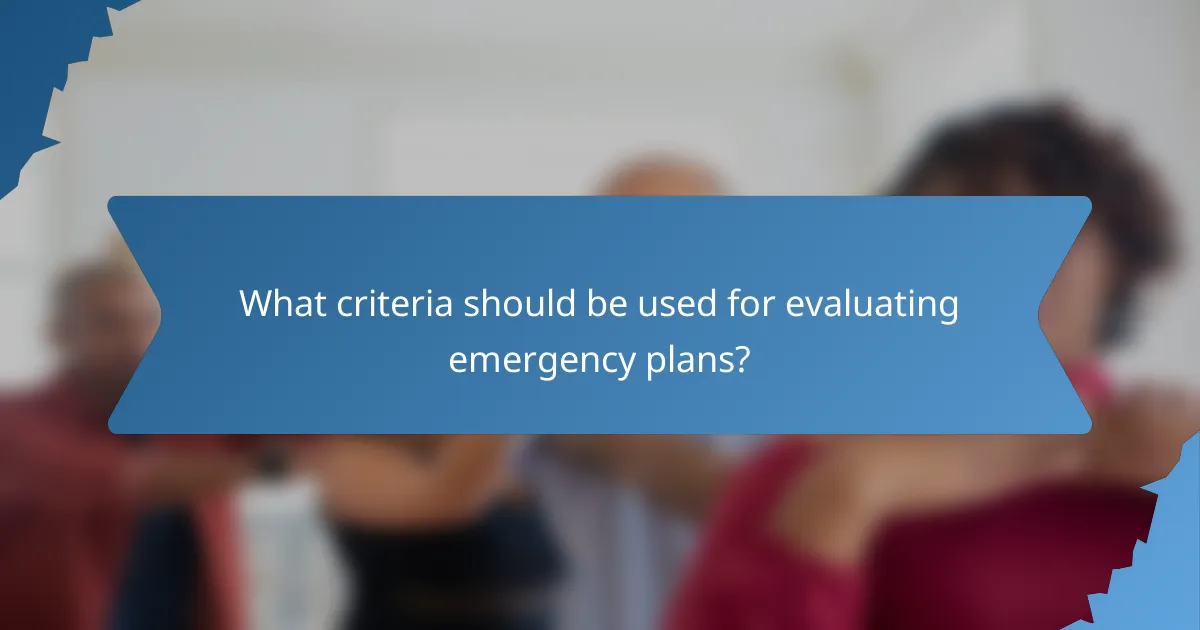
What criteria should be used for evaluating emergency plans?
Evaluating emergency plans requires assessing their compliance with local regulations, the effectiveness of communication strategies, and the involvement of stakeholders. These criteria ensure that the plans are not only legally sound but also practical and inclusive.
Compliance with local regulations
Emergency plans must adhere to local laws and regulations to be considered valid. This includes understanding specific requirements set by local authorities, such as fire codes, health regulations, and disaster management protocols.
Regular reviews of these regulations are essential, as they can change frequently. Organizations should establish a schedule for revising their emergency plans to ensure ongoing compliance and avoid potential legal issues.
Effectiveness of communication strategies
Clear communication is vital during emergencies. Evaluate how well the emergency plan outlines communication protocols, including who communicates what information and through which channels.
Consider conducting drills to test these strategies. Feedback from these exercises can highlight weaknesses in communication methods, allowing for adjustments that enhance clarity and responsiveness during real emergencies.
Involvement of stakeholders
Engaging stakeholders in the development and review of emergency plans is crucial. This includes employees, local emergency services, and community members who may be affected by the plan.
Regular meetings and feedback sessions can foster a sense of ownership and ensure that diverse perspectives are considered. This collaborative approach can lead to more effective and comprehensive emergency plans that better serve the community’s needs.
